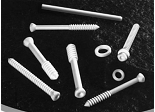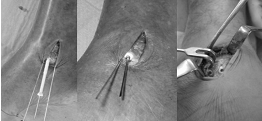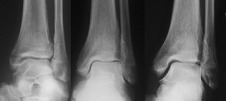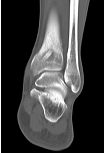|
Abstract:
Introduction: The purpose of this study was to retrospectively
evaluate the clinical outcomes of ankle fractures treated with
F-u-HA/PLLA
implants.
Patients and Methods:
From June 2004 to September 2008, 75 closed ankle fractures were
treated with
F-u-HA/PLLA implants. Forty-seven patients could be followed
for 6 months or more (average 13.4 months), and their clinical
outcomes were evaluated.
F-u-HA/PLLA screws and/or pins were used for fixation of medial
and/or posterior malleolar fractures. An F-u-HA/PLLA screw was
used as the lag screw for fixation of lateral malleolar
fractures. Radiographic and clinical outcomes
and postoperative complications
were evaluated.
Results: Bone union was achieved in all fractures. The average
ranges of dorsiflexion and plantarflexion of the ankle were 17
degrees (range, 5-20) and 40 degrees (range, 30-45),
respectively. No patients had loss of reduction, implant
failure, deep infection, aseptic bone necrosis, or complications
involving the subcutaneous tissue and skin postoperatively.
Conclusions: F-u-HA/PLLA implants have several advantages over
other bioresorbable implants: 1) higher bending strength than
human cortical bone, 2) osteoconductivity, which promotes bone
bonding and total replacement with bone, 3) stable initial
fixation obtained by binding with surrounding bone, 4) good
biocompatibility throughout the bioresorption processes, and 5)
radio-opacity, which allows postoperative observation on
radiographs.
J.Orthopaedics 2010;7(2)e5
Keywords:
ankle fracture; bioresorbable implant; HA/PLLA
Introduction:
Bioresorbable implants have been used for the fixation of foot
and ankle fractures since the early 1980s1). The
original implants were made primarily of polyglycolic acid (PGA)
and polylactic acid (PLA). Since 1995, we have been using
poly-L-lactic acid (PLLA) implants for the treatment of ankle
fractures and have obtained good clinical outcomes, as reported
previously1). However, the following problems have
been encountered: 1) implants do not combine with bone directly,
but combine with bone via soft tissue, 2) absorption of the
implant and bone replacement take a long time, possibly
resulting in bone canal development, 3) implants cannot be seen
on radiographs during surgery or at postoperative follow-up
because of their radiolucency.
In 1995,
forged composites of unsintered hydro- xyapatite/poly-L-lactide
(F-u-HA/PLLA) implants were developed by Takiron Co. Ltd, Japan,
in an effort to resolve these
problems.
Since 2004, we have been using
F-u-HA/PLLA
implants for fixation of ankle fractures. The purpose of this
study was to retrospectively evaluate the clinical outcomes of
ankle fractures treated with
F-u-HA/PLLA implants.
Materials
and Methods:
Between June 2004 and September 2008, 75 closed ankle fractures
were treated with
F-u-HA/PLLA implants. Follow-up of 6 months or more was
available for 47 patients, 26 males and 21 females. According
to the AO/OTA fracture classification system, 12 patients were
43B1, 1 43B2, 2 44A3, 6 44B1, 4 44-B2, 16 44B3, 2 44C1 and 4
44C2. The average age at surgery was 49 years (range, 16-77
years).
Treatment protocol
Two F-u-HA/PLLA screws (diameter, 4.5 mm) were used for medial
malleolar fractures. If the distal fragment was small, a screw
and a pin were used for fracture fixation.
From June 2004 to October 2007, solid screws were used. Since
October of 2007, cannulated screws have been used for this
procedure (Fig. 1). In patients with a posterior tuberosity
fracture, one or two screws were used
for fracture fixation. For lateral malleolar fractures, a
titanium plate and screws (SPS Fibula Plate, Stryker, Mahwah)
were used and an F-u-HA/PLLA screw (diameter, 3.5 mm) was used
as the lag screw
(Fig. 2).
If an anterior tibiofibular ligament rupture was present, a
stainless steel staple (S -type staple, Mizuho, Japan) was used
for fixation of the syndesmosis. Postoperative cast
immobilization lasted 2 to 3 weeks. Partial weightbearing was
started at 3 to 6 weeks, and full weightbearing was allowed at 6
to 10 weeks after surgery.

Figure 1: Two F-u-HA/PLLA cannulated screws were used for
medial malleoral fracture.

Figure 2: An F-u-HA/PLLA screw was used as the lag screw
for lateral malleoral fracture.
Evaluation
The average follow-up was 13.4 months (range, 6-55 months).
Bone union was evaluated radiographically and was defined as
three cortices of bony bridging. Range of motion was evaluated
clinically. Any postoperative complications were recorded.
Results :
Bone union was achieved in all fractures. The average ranges of
dorsiflexion and plantarflexion of the ankle were 17 degrees
(range, 5-20 degrees) and 40 degrees (range, 30-45 degrees),
respectively. No patient had loss of reduction, implant
failure, deep infection, aseptic bone necrosis, or complications
involving the subcutaneous tissue and skin postoperatively. All
47 patients returned to pre-injury activity of daily living.
Representative case
A 61-year-old male sustained a type AO 43-B1 medial malleolar
fracture. Two solid F-u-HA/PLLA screws (diameter, 4.5 mm) were
used for fixation of the fracture. Bone union was achieved, and
there were no postoperative complications. The ranges of
dorsiflexion and
plantarflexion of the ankle were 20 degrees and 40 degrees,
respectively.
On radiographs, shadows of the screws were clearly identifiable
1 month after surgery, but they were less visible 4 years after
the surgery, suggesting that the process of absorption and
decomposition had progressed. There were no osteolytic findings
in the bone around the screws
(Fig. 3).
On CT obtained 4.5 years after surgery, shadows of the screws
were barely visible and there were no gaps around them
(Fig. 4).

Figure 3: A 61-year-old male sustained a type AO 43-B1
medial malleolar fracture.

Figure 4: CT obtained at 4.5 years after the surgery.
Discussion :
Advantages of bioresorbable implants used for fracture fixation
include avoidance of a second procedure for removal of the
implants, potentially reducing the economic and social burdens
on patients, and the elasticity of the implants, possibly
preventing osteoporotic changes in the bone.
F-u-HA/PLLA is a composite structure consisting of cubes of
unsintered hydroxyapatite (u-HA) particles. A thin PLLA film
between the u-HA particles provides an interface with invading
water molecules, which allows homogeneous hydrolysis and steady
degradation of the PLLA.
The strength of
F-u-HA/PLLA
implants is higher than that of PLLA-only implants, and their
degradation and absorption times are shorter than those of PLLA-only
implants2)3).
Other advantages of F-u-HA/PLLA
implants over PLLA-only implants include higher bending strength
than human cortical bone; osteoconductivity, which promotes bone
bonding and total replacement with bone; strong initial fixation
obtained by binding with surrounding bone; good biocompatibility
throughout the bioresorption processes; and radio-opacity that
allows postoperative observation on radiographs.
In 2000, we4) reported good clinical outcomes in 60
patients with ankle fractures treated with PLLA implants. In
2005, Jainandunsing et al. 5) examined numerous
randomized controlled trials and quasi-randomized trials
comparing bioresorbable osteosynthesis with metal osteosynthesis
and found no significant differences between the bioresorbable
and other implants with respect to functional outcomes,
infections, and other complications, and re-operation rates were
lower in some of the groups treated with bioresorbable
implants. They concluded that in a select group of compliant
patients the use of bioresorbable fixation devices might be
advantageous.
Postoperative complications also have been reported with the use
of bioresorbable implants. In 1996, Rokkanen et al. 6)
reported the use of bioresorbable implants for bone or ligament
fixation in 2,500 patients over 10 years. Noninfectious
foreign-body reactions were observed at 2 to 3 months
postoperatively in 2.3% of patients with PGA implants but in
none of the patients with PLA implants. In 1998, Böstman et
al. 7) reported that of 1223 patients with malleolar
fractures of the ankle treated with absorbable implants 74
(6.1%) had obvious inflammatory foreign-body reactions to the
implants, and 10 of these 74 patients later developed
osteoarthritis of the ankle. All 10 had been treated with PGA
implants, and no articular damage was found in those who had PLA
implants.
The degradation and absorption of PLA implants are very gradual,
and the implants are degraded by uniform hydrolysis from the
surface and/or the center. Postoperative complications such as
osteolysis and skin ulcers are uncommon with the use of PLA
implants, in contrast to PGA devices which dissolve rapidly.
In 2005, Shikinami et al.
3)
described complete bioresorption and bone replacement of F-u-HA/PLLA
rods implanted in the femoral medullary cavities of rabbits.
Nearly all of the u-HA particles were replaced with natural bone
after 5.5 years, with no significant foreign-body reaction or
inflammation. In our study, on CT images obtained 4.5 years
after the surgery, shadows of the F-u-HA/PLLA screws were barely
visible and there were no gaps around them, suggesting that the
processes of
degradation and absorption of the
screws had been progressing. CT scanning also showed direct
contact of the HA and the surrounding bone, without inflammatory
reaction.
Furukawa et al.
8)
described direct binding between F-u-HA/PLLA rods implanted in
the distal femurs of rabbits and surrounding bone, as
demonstrated by contact microradiograms
obtained at 25 weeks after implantation. The
osteoconductivity of the implants and their direct binding to
the surrounding bone are advantageous for initial fixation of
the fracture.
These properties decrease postoperative complications such as
loss of reduction and re-fracture. There was no
loss of reduction or implant failure in our 47 patients.
A number of late foreign-body reactions have been described
after the use of bioresorbable implants. Yoshino et al. 9)
reported delayed aseptic swelling 15 months after fixation of a
talar neck fracture with a biodegradable poly-L-lactide rod,
Böstman et al. 10) reported a late foreign-body
reaction 4 years after placement of an intraosseous
bioresorbable PLA screw, and
LaClair
11)
reported an intraosseous bioresorbable PLLA screw presenting as
a late foreign-body reaction 30 months after surgery. In 1999,
one of our patients had a late foreign-body reaction around a
PLLA-only screw head that had degraded and subsequently migrated
into the subcutaneous tissue. Further long-term follow-up is
necessary to determine if late foreign-body reactions will occur
in any of our patients.
The radio-opacity of the F-u-HA/PLLA implants is a major
advantage in checking the positions of implants. Shadows of the
F-u-HA/PLLA implants can be seen on radiographs during surgery
and at postoperative follow- up. Implants made of PGA or PLLA-only
cannot be seen on radiographs.
Fractures of the medial malleolus and posterior tuberosity can
be fixed with
bioresorbable screws and/or pins, but currently no bioresorbable
plate has been developed for lateral
malleolar fractures. In our patients with lateral malleolar
fractures, a titanium plate and screws were used, with a
bioresorbable screw used only as the lag screw. For hardware
removal, the
titanium plate and screws can be removed through two small skin
incisions without wide exposure around the lag screw or damage
to the subcutaneous tissue and periosteum. This is one of the
advantages of using a
bioresorbable screw as
the lag screw.
The higher strength and shorter degradation and absorption times
of
F-u-HA/PLLA
implants compared to PLLA-only implants
make these
devices very useful for the treatment of ankle fractures. At
short-term follow-up, there were no postoperative complications
and bone union with acceptable range of ankle motion was
obtained in all patients; further long-term follow-up is
necessary to confirm continued good results.
Reference :
-
Rokkanen P, Vainionpää S, Törmälä P, Kilpikari J, Böstman O,
Vihtonen K et al. Biodegradable implants in fracture fixation:
early results of treatment of fractures of the ankle. Lancet
1985; 1: 1422-1424
-
Shikinami Y, Okuno M. Bioresorbable devices made of forged
composites of hydroxyapatite (HA) particles and poly-L-lactide
(PLLA): Part I. Basic characteristics. Biomaterials 1999; 20:
859-877
-
Shikinami Y, Matsusue Y, Nakamura T. The complete process of
bioresorption and bone replacement using devices made of
forged composites of raw hydroxyapatite particles/poly L-lactide(F-u-HA/PLLA).
Biomaterials 2005; 26: 5542-5551
-
Takada N, Imaizumi T, Uemura M. Yamada K. Treatment of ankle
fractures using bioabsorbable implants. Journal of Tohkai
Orthopaedic Society of Traumatology 13: 96~98,
2000. (in Japanese)
-
Jainandunsing JS, van der Elst M, van der Werken CC.
Bioresorbable fixation devices for musculoskeletal injuries in
adults. The Cochrane Database of Systematic Reviews Issue 4,
2005.
-
Rokkanen P, Bӧstman OM, Vainionpää S, Makela EA, Hirvensalo E,
Partio EK, et al. Absorbable Devices in the Fixation of
Fractures. The Journal of Trauma 1996; 40: S123-127
-
Bӧstman
OM. Osteoarthritis of the ankle after foreign-body reaction to
absorbable pins and screws. Journal of Bone and Joint Surgery
1998; 80B: 333~338
-
Furukawa T, Matsusue Y, Yasunaga T, Nakagawa Y, Okada Y,
Shikinami Y, et al. Histomorphometric study on high-strength
hydroxyapatite/poly(L-lactide) composite rods for internal
fixation of bone fractures. Journal of Biomedical Materials
Research 2000; 50: 410-419
-
Yoshino N, Takai S, Watanabe Y, Kamata K, Hirasawa Y. Delayed
Aseptic Swelling after Fixation of Talar Neck Fracture with a
Biodegradable Poly-L-Lactide Rod: Case Reports. Foot and Ankle
International 1998; 19: 634-637
-
Bӧstman
OM, Pihlajamäki HK. Late Foreign-Body Reaction to an
Intraosseous Bioabsorbable Polylactic Acid Screw. Journal of
Bone and Joint Surgery 19998; 80A: 1791~1794
-
Mosier-LaClair S, Pike H, Pomeroy G. Intraosseous
Bioabsorbable Poly-L-Lactic Acid Screw Presenting as a Late
Foreign-Body Reaction: A Case Report. Foot and Ankle
International 2001; 22: 247~251
|






